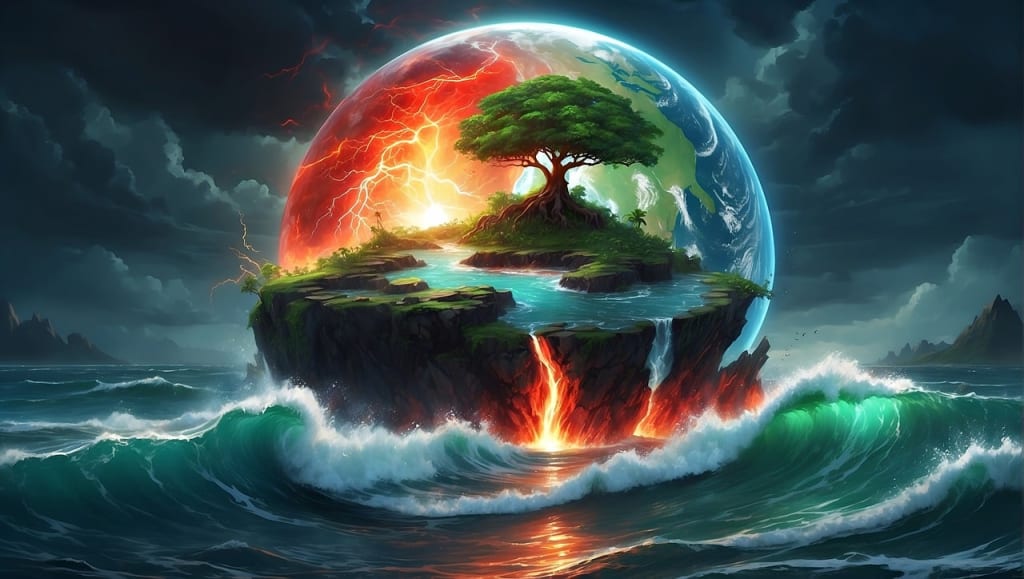Where does the word water come from?
Why does only Earth have water and other planets do not?

"Where does water come from?". A seemingly common question but it will startle most of us because... we don't know.
Billions of years ago, there was no such thing as the Earth or the solar system, but only a giant cloud of gas and dust in the universe. The density in the center of this cloud is the condition for the formation of the sun, the only star of the solar system. After the sun formed, solar wind carrying extremely hot temperatures combined materials in its path to form what we call "planets".
At that time, there wasn't any sign of water in the solar system. So how does our Earth have water? Below are a few hypotheses put forward.
Hydrogen was the first atom to form after the Big Bang, followed by Helium and small amounts of Lithium. Basic atoms are often fused together to form heavy atoms (like oxygen). When hydrogen atoms come into contact with oxygen atoms, water is formed as thick layers of ice on rocky structures in space. These rocks collided with each other and formed larger and more stable structures that eventually formed planets.
This is a theory about the origin of water that revolves around the idea that the Earth was formed from ice blocks that retained water after colliding with each other. Under the sun, the water on the surface evaporates, but the water incorporated in the rocks seeps back into the surface and the planet begins to cool. As air forms, more water is condensed.
Some scientists believe that water did not exist on Earth or any planet during the formation of the solar system. Instead, it is speculated that the water came from places other than the solar system in comets, asteroids or meteorites. Because they are far away from the sun, the water (ice) present on these cosmic objects is not melted and evaporated by the sun's temperature. Comets, Trans-Neptunian Bodies, or water-rich meteorites from the asteroid belt that collided with Earth may have brought water to Earth.
In a new study, a team of scientists led by Professor Akira Kouchi explains that heating interstellar organic matter to extremely high temperatures can produce a lot of water and oil. This shows that water can be produced from within the ice line without the contribution of comets or meteorites.
Internal source
The internal source is considered to be from the chemical composition of cosmic matter when it gathered to form the Earth. Water in the atmosphere when the solid crust formed, water gradually released from the Earth's mineral hydrates, water released from volcanic eruptions, may have formed part of the existing water. As the Earth cools, the amount of water condensing to create oceans increases.
By analyzing ancient rock layers on Baffin Island (Canada), researchers have found authentic evidence that water is something that has always existed on our Earth. These rock layers come from the Earth's crust - that is, they are not affected by external factors. And the water found in it had the same composition as the water we still see today.
With the goal of shedding light on the origin of life and the formation of the universe, researchers are analyzing materials including 5.4 grams of rock and sand/dust grains collected by the Japanese Hayabusa2 space probe. Collected from asteroid Ryugu and brought back to Earth in 2020.
Studies on these specimens are gradually being revealed. In June this year, a team of researchers said they had found organic material suggesting that some of the building blocks of life on Earth - amino acids - may have been formed in space.
In the latest research published in the journal Nature Astronomy On August 15, Japanese and international scientists said that samples collected from the asteroid Ryugu could provide "clues" to solve the mystery of how oceans appeared on Earth. from billions of years ago.
According to research, volatile and organic-rich C-type asteroids could be one of Earth's main sources of water. The supply of volatiles (including organic matter and water) to Earth is still a subject of much debate. However, the organic materials found in sand/dust grains from asteroid Ryugu through this study may represent an important source of volatiles.
Scientists hypothesize that such material could have an "extrasolar origin", but "it is unlikely that it was the sole source of volatiles delivered to the early Earth".
Recently, a hypothesis published by the Japan Aerospace Exploration Agency in the scientific journal Nature Astronomy shows evidence that asteroids from the edge of the Solar System are more than 4.5 billion km away from us. may have provided the origin of life on primitive Earth.
This hypothesis is drawn from the analysis of material samples from the asteroid Ryugu (300 million km from Earth) collected by the Hayabusa2 space probe.
Here, scientists discovered a composition almost identical to water on Earth, with some small differences. This leads them to believe that ancient Earth may have stored water from other places outside the universe, represented by asteroids and meteorites.
Interestingly, the organic matter and water found on asteroid Ryugu was not liquid, but rather a hydroxyl group consisting of an oxygen atom bonded to a hydrogen atom. It is known that similar ingredients are also found in cosmic dust and comets.
This structure is protected by a phyllosilicate shell to withstand harsh environmental changes in space, and only truly develops when encountering favorable conditions on Earth.
"In a broad sense, it can be understood that small celestial bodies carried things that led to water and life," said Motoo Ito, a senior researcher in geomaterials science at the Japan Science and Technology Agency. live on Earth".
However, the question "how the Earth, which was originally covered with molten magma during its formation, became submerged in water" remains a mystery.
The Hayabusa2 space probe left Earth in 2014. After 4 years, the spacecraft reached a stationary position on the asteroid Ryugu. Previously, the ship had traveled a distance of 3.2 billion km on an elliptical orbit around the Sun.
In total, the probe touched down on the asteroid twice, collected subsurface samples, and sent them back to Earth. Thanks to the analyzed data, researchers have discovered that the asteroid Ryugu originated from a parent planet, formed outside the Solar System.
After many years, it traveled to our star system, carrying with it water molecules and particles containing amino acids - organic compounds believed to be the "source of life".
About the Creator
Culture Discovery
Mysterious things are always an attractive topic and stimulate people's curiosity. From unexplained supernatural phenomena, mysterious ancient relics, to mysterious and dark stories the world is full of mysteries waiting to be discovered.






Comments (1)
Interesting read. Thank you for sharing this